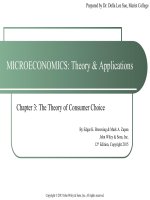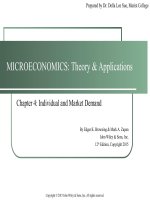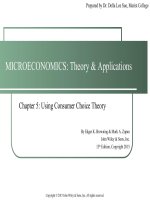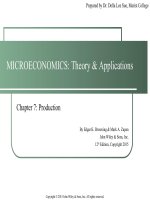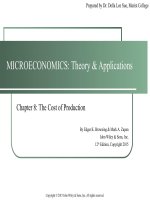MicroEconomics theory and application 12th by browning an zupan chapter 09
Bạn đang xem bản rút gọn của tài liệu. Xem và tải ngay bản đầy đủ của tài liệu tại đây (571.48 KB, 45 trang )
Prepared by Dr. Della Lee Sue, Marist College
MICROECONOMICS: Theory & Applications
Chapter 9: Profit Maximization in Perfectly
Competitive Markets
By Edgar K. Browning & Mark A. Zupan
John Wiley & Sons, Inc.
12th Edition, Copyright 2015
Copyright © 2015 John Wiley & Sons, Inc. All rights reserved.
Learning Objectives
Outline the conditions that characterize perfect competition.
Explain why it is appropriate to assume profit maximization
on the part of firms.
Show why the fact that a competitive firm is a price taker
implies that the demand curve for the firm is perfectly
horizontal.
Explain a competitive firm’s optimal output choice in the
short run and how the firm’s shortrun supply curve may be
derived through this output selection.
Describe the firm’s short-run supply curve.
(continued)
Copyright © 2015 John Wiley & Sons, Inc. All rights reserved.
2
Learning Objectives
(continued)
Explain how the short-run industry supply curve is derived.
Define the conditions characterizing long-run competitive
equilibrium.
Understand how the long-run industry supply curve
describes the relationship between price and industry output
over the long run, taking into account how input prices may
be affected by an industry’s expansion/contraction.
Analyze the extent to which the competitive market model
applies.
Delineate the mathematics behind perfect competition.
Copyright © 2015 John Wiley & Sons, Inc. All rights reserved.
3
Outline the conditions that characterize perfect competition.
9.1 THE ASSUMPTIONS OF PERFECT
COMPETITION
Copyright © 2015 John Wiley & Sons, Inc. All rights reserved.
4
The Assumptions of Perfect
Competition
Large numbers of buyers and sellers
Free entry and exit
Product Homogeneity
Perfect information
Copyright © 2015 John Wiley & Sons, Inc. All rights reserved.
5
Explain why it is appropriate to assume profit maximization on the part of
firms.
9.2 PROFIT MAXIMIZATION
Copyright © 2015 John Wiley & Sons, Inc. All rights reserved.
6
Profit Maximization
Assumption: firms select an output level so as to maximize
profit, defined as the difference between revenue and cost
“Survivor Principle” – the observation that in competitive
markets, firms that do not approximate profit-maximizing
behavior fail, and that survivors are those firms that,
intentionally or not, make the appropriate profit-maximizing
decisions.
Copyright © 2015 John Wiley & Sons, Inc. All rights reserved.
7
Show why the fact that a competitive firm is a price taker implies that the
demand curve for the firm is perfectly horizontal.
9.3 THE DEMAND CURVE FOR A
COMPETITIVE FIRM
Copyright © 2015 John Wiley & Sons, Inc. All rights reserved.
8
The Demand Curve for a Competitive Firm
Price taker – a firm that takes prices as given and does not
expect its output decisions to affect price
=>horizontal demand curve
Total revenue (TR) – price times the quantity sold
Average revenue (AR) – total revenue divided by output
Marginal revenue (MR) – the change in total revenue
when there is a one-unit change in output
Copyright © 2015 John Wiley & Sons, Inc. All rights reserved.
9
Figure 9.1 - The Competitive Firm’s
Demand Curve
Copyright © 2015 John Wiley & Sons, Inc. All rights reserved.
10
Explain a competitive firm’s optimal output choice in the short run and
how the firm’s shortrun supply curve may be derived through this output
selection.
9.4 SHORT-RUN PROFIT
MAXIMIZATION
Copyright © 2015 John Wiley & Sons, Inc. All rights reserved.
11
Short-Run Profit Maximization
Total profit (π) – the difference between total revenue and
total cost
TR rises in proportion to output since the price is constant.
TC rises slowly at first and then more rapidly as the plant
facility becomes more fully utilized and MC rises.
Total profit tends to increase and then decrease as more is
produced.
Copyright © 2015 John Wiley & Sons, Inc. All rights reserved.
12
Table 9.1
Copyright © 2015 John Wiley & Sons, Inc. All rights reserved.
13
Figure 9.2 - Short-Run Profit
Maximization: Total Curves
Copyright © 2015 John Wiley & Sons, Inc. All rights reserved.
14
Short-Run Profit Maximization
Using Per-unit Curves
Average profit per unit (π/q) – total profit divided by
number of units sold
Profit is maximized at the output level where MR=MC.
If MR>MC, profits would increase if output were increased.
If MR
Copyright © 2015 John Wiley & Sons, Inc. All rights reserved.
15
Figure 9.3 - Short-Run Profit
Maximization Using Per-unit Curves
Copyright © 2015 John Wiley & Sons, Inc. All rights reserved.
16
Operating at a Loss in the Short-Run
If ATC<AR at the output-level where MC=MR => profit is
negative
Two choices:
Temporarily shut-down
Permanently go-out-of-business
Question: Which choice will yield smaller loss?
Copyright © 2015 John Wiley & Sons, Inc. All rights reserved.
17
Figure 9.4 - Operating at a Loss in the
Short-Run
Copyright © 2015 John Wiley & Sons, Inc. All rights reserved.
18
Describe the firm’s short-run supply curve.
9.5 THE PERFECTLY COMPETITIVE
FIRM’S SHORT-RUN SUPPLY CURVE
Copyright © 2015 John Wiley & Sons, Inc. All rights reserved.
19
The Perfectly Competitive Firm’s Short-Run
Supply Curve
Short-run firm supply curve – a graph of the systematic
relationship between a product’s price and a firm’s most
profitable output level
Supply curve = MC curve where MC > minimum point
on AVC curve
Identifies most profitable output for each possible price
Shutdown point – the minimum level of average variable
cost below which the firm will cease operations
Copyright © 2015 John Wiley & Sons, Inc. All rights reserved.
20
Figure 9.5 - A Competitive Firm’s
Short-Run Supply Curve
Copyright © 2015 John Wiley & Sons, Inc. All rights reserved.
21
Output Response to a Change in Input
Prices
Question: What is the impact of a change in input price,
holding product price constant?
1) MC will shift
2) Firm will adjust output until MC=MR
Copyright © 2015 John Wiley & Sons, Inc. All rights reserved.
22
Figure 9.6 – How a Firm Responds to
Input Prices Changes
Copyright © 2015 John Wiley & Sons, Inc. All rights reserved.
23
Explain how the short-run industry supply curve is derived.
9.6 THE SHORT-RUN INDUSTRY
SUPPLY CURVE
Copyright © 2015 John Wiley & Sons, Inc. All rights reserved.
24
The Short-Run Industry Supply Curve
Short-run industry supply curve – add the quantities produced by
each firm by summing the individual firms’ marginal cost curves
horizontally
Assumption – variable input prices remain constant at all levels of
industry output
Curve slopes upward due to law of diminishing marginal returns
Market price and output: determined by interaction between short-run
industry supply curve and the market demand curve
Copyright © 2015 John Wiley & Sons, Inc. All rights reserved.
25




